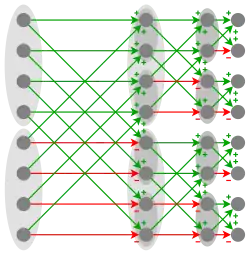
.svg.png.webp)
In computational mathematics, the Hadamard ordered fast Walsh–Hadamard transform (FWHTh) is an efficient algorithm to compute the Walsh–Hadamard transform (WHT). A naive implementation of the WHT of order would have a computational complexity of O(). The FWHTh requires only additions or subtractions.
The FWHTh is a divide-and-conquer algorithm that recursively breaks down a WHT of size into two smaller WHTs of size . [1] This implementation follows the recursive definition of the Hadamard matrix :
The normalization factors for each stage may be grouped together or even omitted.
The sequency-ordered, also known as Walsh-ordered, fast Walsh–Hadamard transform, FWHTw, is obtained by computing the FWHTh as above, and then rearranging the outputs.
A simple fast nonrecursive implementation of the Walsh–Hadamard transform follows from decomposition of the Hadamard transform matrix as , where A is m-th root of . [2]
Python example code
def fwht(a) -> None:
"""In-place Fast Walsh–Hadamard Transform of array a."""
h = 1
while h < len(a):
# perform FWHT
for i in range(0, len(a), h * 2):
for j in range(i, i + h):
x = a[j]
y = a[j + h]
a[j] = x + y
a[j + h] = x - y
# normalize and increment
a /= math.sqrt(2)
h *= 2
See also
References
External links
- Charles Constantine Gumas, A century old, the fast Hadamard transform proves useful in digital communications